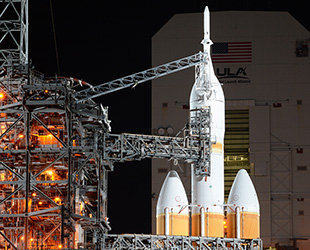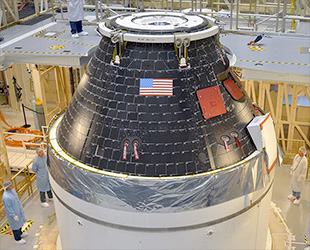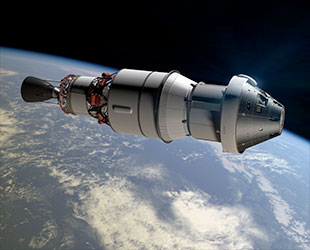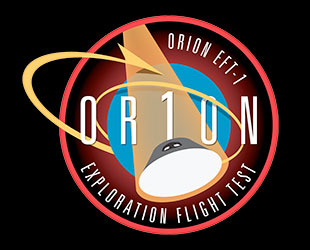December 5, 2014 — NASA's "first step to deep space" has launched into Earth orbit.
The space agency's first prototype Orion capsule lifted off Friday morning (Dec. 5) on a four and a half hour flight test aimed at proving the effectiveness of the new spacecraft's heat shield and other systems needed to send astronauts beyond the Earth, to an asteroid and ultimately Mars. The uncrewed mission, called Exploration Flight Test-1 (EFT-1), is the first time since the Apollo program that a NASA space capsule designed for a crew has flown.
"[This flight] is building upon the legacy of Apollo," NASA Administrator Charles Bolden told collectSPACE.com in a press conference held at the launch pad Wednesday. "For the first time in more than 40 years, this nation is going to launch a spacecraft intended to carry humans beyond low-Earth orbit. That's a big deal."
The Orion left Earth atop a United Launch Alliance Delta 4 Heavy rocket, the world's most powerful rocket still flying today, from Complex 37B at the Cape Canaveral Air Force Station, Florida. The launch came on the rocket's second attempt. On Thursday, the liftoff was scrubbed as a result of some of the Delta's hydrogen fill-and-drain valves failing to close.
By Friday, the problem was resolved and the rocket lifted off at 7:05 a.m. EST (1205 GMT). The 243-foot-tall (74 m.) launch vehicle soared skyward into the morning sky riding the thrust of its three RS-68 engines, before shedding two of its common core boosters four minutes into the flight.
"It all comes to life with two million pounds of thrust, lifting Orion on just a fountain of fire at an impossible speed out into space," United Launch Alliance chief executive officer Tory Bruno said.

A day before launch, the Delta 4 Heavy topped by the Orion stack was revealed for flight as the mobile service tower at the Cape Canaveral Air Force Station's Complex 37 rolled back. (cS) |
The Delta 4's first stage dropped away about a minute and a half later, leaving the second stage engine to push Orion through the rest of its two orbit mission. Six minutes and 15 seconds into flight, the four-panel fairing that shielded the capsule's mock service module during the ascent was jettisoned, followed five seconds later by the launch abort system tower.
Almost eighteen minutes after lifting off, the second stage engine cut off as scheduled, signaling Orion's arrival in its initial orbit, some 115 miles (185 kilometers) above Earth.
Fifty-five percent
The Orion spacecraft for this mission is made up primarily of four parts, each being tested on EFT-1: a crew module, a mockup of a service module, a mostly-inert launch abort system, and an Orion-to-stage adapter. Lockheed Martin, as NASA's lead contractor for the spacecraft, built Orion and managed the EFT-1 mission.
Overall, 55 percent of the Orion systems required for the capsule's first crewed mission, Exploration Mission-2 (EM-2), currently targeted for 2021, are being demonstrated for the first time in space on EFT-1. Most of the outstanding systems comprise the service module, which for EM-2 will be delivered by the European Space Agency (ESA), and the interior of the crew module.

The EFT-1 Orion, as seen before it was encapsulated for launch. The black thermal tiles covering its back shell were carried over from the space shuttle program. (NASA) |
"If you were to look inside the [EFT-1] crew module, what you'd see is the back shell, which is basically a structural component that lays out volumes where we put computers mounted in there," NASA's Orion program manager Mark Geyer told collectSPACE. "Then we also have the thermal control systems, so you'd see some valves and the tubes that keep it cold by supplying coolant."
"You'd also see a couple of bags of flags and [mementos] that you normally fly on a mission like this," Geyer added, "and then you'd see a lot of wiring because the computers inside are controlling the thermal control system, as well as the prop system and the other avionics that are outside the vehicle."
What you wouldn't see, Geyer explained, is the equipment for an astronaut crew.
"We do not have seats, but we do have mass simulators inside that make the vehicle feel like it had seats there," he said. "You'd also see a mass simulator for the displays and controls panel. We are trying to make sure we know how the struts react to that mass, because that hangs off [the back shell]."
Next stop: 3,600 miles high
The primary goal of EFT-1 is to test the Orion's 16.5-foot (5-meter) heat shield, the largest ever built. To do so, the 19,000 pound (8,600 kilogram) spacecraft will be boosted 3,609 miles (5,808 kilometers) above Earth, high enough that its speed on return will result in re-entry temperatures of about 80 percent of what it would encounter on a return from the moon.
Its cone-shaped back shell covered by 970 black thermal tiles — the same as those used on the space shuttle, the Orion's heat shield is covered by a honeycomb structure filled with a material that was derived from Apollo. Called Avcoat, the ablative shield will burn away as it's subjected to temperatures nearing 4,000 degrees Fahrenheit (2,800 degrees Celsius).

An artist concept shows Orion in orbit during Exploration Flight Test-1 attached to a Delta 4 cryogenic second stage. (NASA) |
Before it re-enters though, the Orion will be exposed to a different type of harsh environment: the radiation belts.
Flying almost 14 times farther than where the International Space Station orbits Earth, the capsule will encounter the Van Allen Belts, clouds of heavy radiation surrounding the planet. No spacecraft built for humans has passed through the Van Allen belts since the Apollo missions, and unlike the Orion on this mission, they didn't linger.
EFT-1's extended radiation exposure will offer the chance to measure how Orion's shields hold up. Sensors mounted in the capsule will record the peak and general radiation levels throughout the flight.
Demonstrating descent
Three hours and 23 minutes after the start of its flight, the Orion capsule will separate from the Delta 4 second stage and discard of its mock service module.
Descending from its highest altitude to the Pacific Ocean in just an hour and a half, the Orion, once back inside the atmosphere, will deploy eight parachutes — two drogues, three pilot parachutes and three mains — to descend to a soft splash down.
Waiting for Orion's arrival about 600 miles (965 kilometers) south of San Diego, Calif. are the U.S. Navy's amphibious ship, the USS Anchorage, and salvage ship, the USNS Salvor. Navy divers in Zodiac boats will check the capsule for any hazards before guiding it to enter the Anchorage's flooded well deck. Once Orion is inside, the water will be drained, leaving the Orion secure and dry for the trip back to shore.
The Salvor, together with four rigid-hull inflatable boats will be used to recover Orion's parachutes and its forward bay cover.
Journey to Mars
Friday's Orion test flight is taking place 16 years and one day after another NASA launch milestone: the first United States' flight to assemble the International Space Station. And like the liftoff of the Unity node on Dec. 4, 1998, the legacy of EFT-1 will be defined by where it leads.

NASA's Orion Exploration Flight Test-1 (EFT-1) insignia. (NASA) |
NASA has manifested its second Orion capsule with an ESA-supplied service module to fly on the maiden flight of its advanced heavy-lift rocket, the Space Launch System (SLS). Although the Delta 4 Heavy had the thrust needed to boost the Orion to 3,600 miles high, the SLS is needed to launch the Orion on longer journeys further out into the solar system.
NASA's Exploration Mission-1 (EM-1) is targeted to launch in 2018 on a journey around the moon.
The first Orion to be crewed will fly Exploration Mission-2 (EM-2), slated for 2021. NASA has proposed using EM-2 to rendezvous with a robotically-retrieved asteroid, though as it currently stands, the flight will also orbit the moon.
Ultimately, NASA considers the Orion spacecraft to be its first step toward the journey to Mars. The space agency is working to send a crew to orbit the Red Planet by the mid-2030s.
